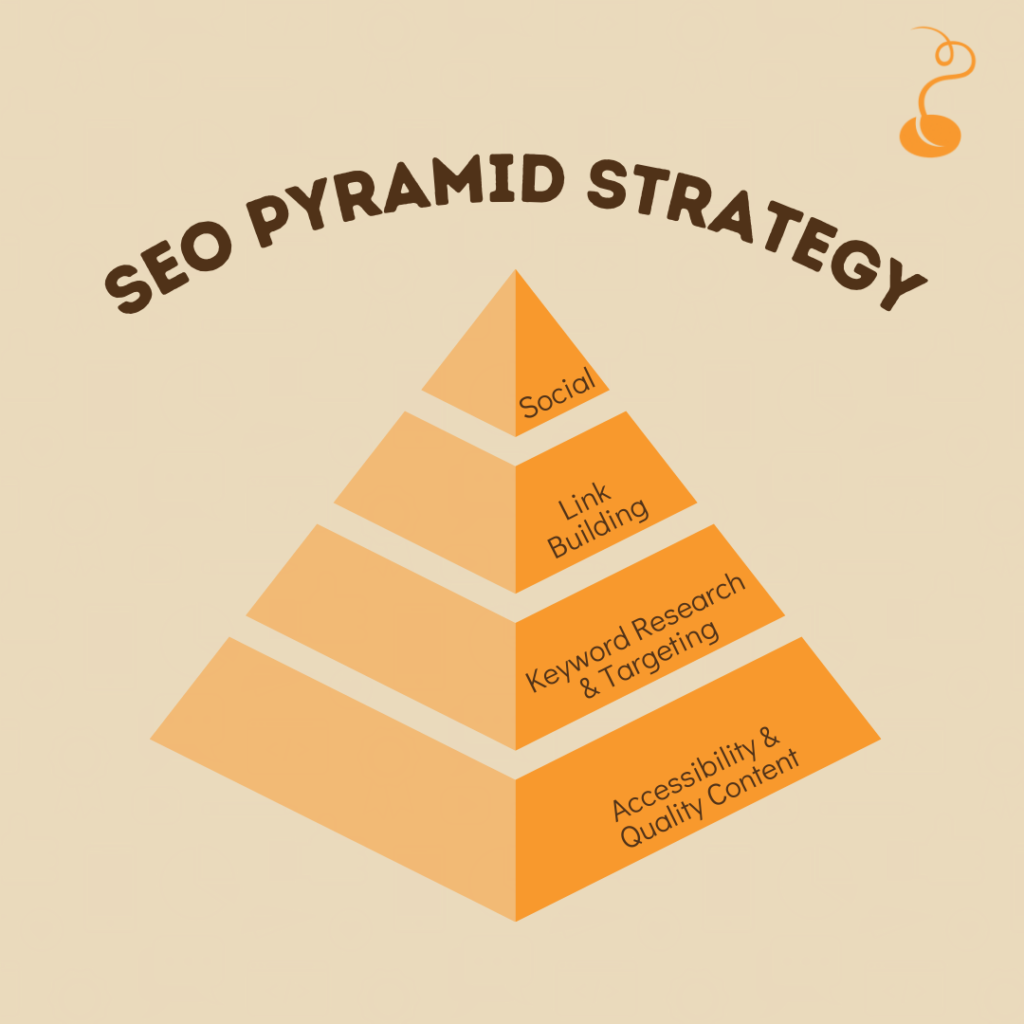In the realm of search engine optimization (SEO), strategies and techniques are continually evolving to keep up with the dynamic algorithms of search engines like Google. One approach that has gained significant traction in recent times is the concept of a Link Pyramid. In this comprehensive guide, we delve into the intricacies of link pyramids, their purpose, and how you can leverage them to boost your website’s online visibility and authority.

What is a Link Pyramid? Unveiling the Structure
A Link Pyramid is a strategic framework for building backlinks that follows a tiered structure, resembling that of a pyramid. The primary objective behind this technique is to establish a strong and authoritative link profile for your website. The structure typically comprises three tiers:
- Tier 1 – The Base: At the base of the pyramid, you have the highest quality and most authoritative backlinks. These links originate from well-established and reputable websites. The focus here is on quality over quantity, as these backlinks serve as the foundation of the pyramid.
- Tier 2 – The Middle Layer: Moving up the pyramid, the second tier consists of backlinks that support the ones in the first tier. These links are usually from diverse sources and can include blog comments, social bookmarks, and forum posts. While the authority of these links may be slightly lower, they contribute to the overall strength of the pyramid.
- Tier 3 – The Top Apex: The third and final tier, often the largest in terms of quantity, consists of links pointing to the second-tier backlinks. These can be from various sources like web 2.0 properties, article directories, and less authoritative blogs. The purpose of this tier is to boost the authority of the second-tier links, which, in turn, bolster the authority of the first-tier links.
Also Check Achieving Top SEO Rankings: The Ultimate Guide to Dominating the Search Results 2023
The Purpose and Benefits of a Link Pyramid
Link pyramids are designed to serve multiple purposes that collectively enhance your website’s SEO efforts:
- Diverse Backlink Profile: By incorporating backlinks from various sources and platforms, a link pyramid creates a natural and diverse profile, signaling to search engines the legitimacy of your website.
- Authority Amplification: The tiered structure of the pyramid enables the flow of authority from lower-tier links to higher-tier ones, eventually strengthening the most crucial links that directly point to your website.
- Mitigating Risks: As you distribute backlinks across different tiers, the risk of over-optimization or potential penalties from search engines is minimized. This balanced approach ensures a safer SEO strategy.
- Gradual Indexing: The tiered approach allows search engines to discover and index your backlinks gradually, mimicking a natural link-building process and avoiding any sudden spikes that could raise suspicions.

Implementing a Successful Link Pyramid Strategy
Creating an effective link pyramid necessitates a systematic approach:
- Keyword Research: Identify relevant keywords that align with your content and target audience. These keywords will guide your link-building efforts.
- Tier Planning: Strategically plan your tiers, ensuring the first tier consists of high-authority sites, the second tier supports them, and the third tier amplifies their strength.
- Content Quality: Craft high-quality, engaging content for each tier, including informative articles, blog posts, and even visual content like infographics.
- Natural Progression: Focus on a gradual and organic progression of building backlinks. Avoid sudden spikes that might trigger search engine suspicion.
- Consistent Monitoring: Regularly assess the performance of your link pyramid using SEO tools. Replace or update links as needed to maintain relevancy and authority.

Unveiling the Link Pyramid Strategy: Elevate Your SEO Game
Welcome to our comprehensive guide on leveraging the powerful Link Pyramid strategy to enhance your website’s SEO prowess and dominate the digital landscape. As leaders in the field of search engine optimization, we are excited to share with you a strategic approach that has the potential to outperform competitors and secure top rankings on Google. Let’s dive into the world of Link Pyramids and how they can revolutionize your online presence.
Understanding the Link Pyramid Strategy
In the dynamic world of SEO, staying ahead demands innovative approaches, and the Link Pyramid strategy is a gem in this realm. The concept is simple yet profoundly effective. Imagine building a strong foundation for your website’s backlink profile, gradually amplifying its authority, and establishing a diverse range of connections that captivate search engines. This is the essence of the Link Pyramid.

The Tiered Structure: Laying the Foundation for Success
At the core of the Link Pyramid strategy lies its unique tiered structure. Picture a pyramid with three distinct tiers, each playing a crucial role in fortifying your website’s online authority:
Tier 1 – The Bedrock of Authority
At the base of the pyramid, Tier 1 consists of top-tier, high authority websites that act as the bedrock of your backlink profile. These are the cream of the crop, reputable and trustworthy sources that lend your website credibility and trustworthiness in the eyes of search engines. Think of these backlinks as the pillars upon which the rest of the pyramid stands.
Tier 2 – Strengthening the Foundation
Moving up the pyramid, we encounter Tier 2, the supporting layer that bolsters the authority of Tier 1 backlinks. These links originate from a diverse array of platforms, including blog comments, social bookmarks, and forums. They provide a natural link-building progression, indicating to search engines that your website is gaining traction and recognition across various online communities.
Tier 3 – The Apex of Amplification
Finally, Tier 3 forms the apex of the pyramid, consisting of links that amplify the strength of Tier 2 backlinks. These can be from sources like web 2.0 properties, article directories, and less authoritative blogs. The purpose here is twofold: to further enhance the authority of Tier 2 links and to create a dynamic and nuanced backlink profile that mimics natural growth.

Benefits Beyond Bounds: Why Choose the Link Pyramid Strategy
The Link Pyramid strategy isn’t just about a fancy structure – it offers tangible benefits that can redefine your website’s SEO journey:
- Diversified Link Profile: By encompassing links from different sources and tiers, the Link Pyramid strategy paints a genuine and diverse picture of your website’s popularity.
- Authority Amplification: The tiered structure ensures that authority trickles up, ultimately solidifying the credibility of your website in the eyes of search engines.
- Risk Mitigation: With links distributed strategically across tiers, you minimize the risk of triggering search engine penalties or over-optimization alarms.
- Natural Progression: The gradual link-building process mirrors natural growth, preventing sudden spikes that could raise suspicions.
Implementing the Link Pyramid: A Strategic Approach
To harness the full potential of the Link Pyramid strategy, consider these steps:
- Keyword Research: Identify keywords that align with your content and audience. These keywords will steer your link-building efforts.
- Tier Planning: Devise a comprehensive plan for each tier. Tier 1 should include high authority sites, Tier 2 diverse platforms, and Tier 3 amplification sources.
- Craft Quality Content: Develop engaging content for each tier – articles, blog posts, and even visually appealing infographics.
- Organic Progression: Strive for a gradual, organic link-building rhythm. Avoid sudden spikes that might appear unnatural.
- Regular Assessment: Continuously monitor your link pyramid’s performance through SEO tools. Replace or update links as needed to ensure relevance and authority.
Conclusion: Your Path to SEO Excellence
In the fierce arena of SEO, the Link Pyramid strategy stands tall as a game-changer. Through meticulous tier planning, diversified backlinks, and gradual authority amplification, you possess the tools to ascend the search engine rankings. Remember, the Link Pyramid is just one facet of a comprehensive SEO strategy that embraces quality content, technical optimization, and user engagement. With this guide in hand, you’re equipped to outmaneuver competitors and claim your rightful place atop Google’s search results.
Frequently Asked Questions (FAQ)
Welcome to our FAQ section, where we address common queries about the Link Pyramid strategy and its impact on your website’s SEO. If you have questions, we’ve got answers. Let’s dive in!

Q1: What exactly is a Link Pyramid? A1: A Link Pyramid is a structured approach to building backlinks that involves creating tiers of links with varying degrees of authority. The foundation tier contains high-quality, authoritative links, while the subsequent tiers support and amplify their strength.
Q2: Why should I consider using the Link Pyramid strategy? A2: The Link Pyramid strategy offers several benefits, including a diversified link profile, gradual authority amplification, risk mitigation against search engine penalties, and a natural link-building progression that mirrors organic growth.
Q3: Can I use any type of backlink for each tier? A3: While you can use different types of backlinks for each tier, it’s crucial to maintain relevancy and quality. Tier 1 should consist of high-authority sites, Tier 2 can include diverse sources like blog comments and social bookmarks, and Tier 3 could have links from platforms like web 2.0 properties.
Q4: How do I begin implementing a Link Pyramid strategy? A4: Start with thorough keyword research to guide your efforts. Plan each tier strategically, ensuring that your Tier 1 links come from reputable sources, Tier 2 supports them, and Tier 3 amplifies their authority.
Q5: Is there a risk of over-optimization with a Link Pyramid? A5: By carefully distributing backlinks across tiers and avoiding sudden spikes in link-building activity, you can mitigate the risk of over-optimization. The balanced approach of a Link Pyramid minimizes this concern.
Q6: What role does content play in the Link Pyramid strategy? A6: High-quality content is essential for every tier of the Link Pyramid. Crafting engaging articles, blog posts, and even visual content like infographics adds value and relevance to each backlink.
Q7: How do I monitor the performance of my Link Pyramid? A7: Regularly monitor your Link Pyramid’s performance using SEO tools. Track changes in rankings, traffic, and the authority of your backlinks. Replace or update links when needed to maintain relevancy.
Q8: Can the Link Pyramid strategy be part of a larger SEO plan? A8: Absolutely. The Link Pyramid strategy should be a component of a holistic SEO approach that includes other elements like valuable content creation, technical optimization, and user engagement. It complements and enhances your overall SEO strategy.
Q9: Are there any risks associated with the Link Pyramid strategy? A9: While the Link Pyramid strategy is effective when executed properly, it’s important to stay updated on search engine algorithms and guidelines. Overusing or mismanaging backlinks could potentially lead to penalties.
Q10: Can I see a visual representation of a Link Pyramid? A10: Certainly. Here’s a mermaid diagram illustrating the hierarchical structure of a Link Pyramid: